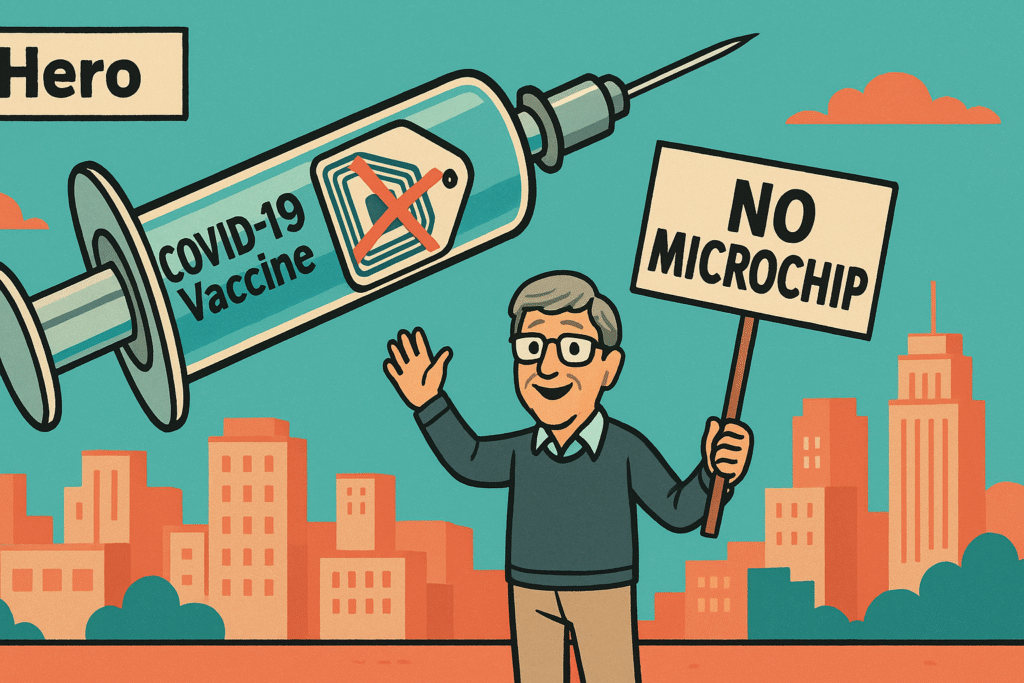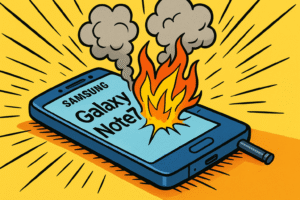The Rise — and Rapid Fall — of the vaccine microchip conspiracy

A year before the first COVID-19 shot went into an arm, social-media feeds were already flooded with warnings that Bill Gates planned to “track” humanity by hiding microchips inside the vaccine. By late-2020 the claim had hardened into one of the pandemic’s most viral falsehoods: the vaccine microchip conspiracy. In Facebook groups, Telegram chats and TikTok “magnet challenge” videos, millions repeated some version of the story:
“They’re putting RFID chips in the jab so the government can follow you.”
In reality, no licensed COVID-19 vaccine contains a tracking device, and no syringe on the mass-vaccination line is capable of injecting one. Global fact-checking teams have debunked every strand of the rumour, engineers have explained the physics that make it impossible, and even the supposed mastermind—Bill Gates—has publicly ridiculed the idea. Below is a detailed autopsy of how the vaccine microchip conspiracy was born, why it spread, and what finally killed it.
Table of Contents
1. Patient Zero: A Mis-Stitched Bill Gates Video

Trigger clip (April 2020).
A 45-second Facebook video spliced together two completely separate moments from a 2013 Bill & Melinda Gates Foundation conference talk. In the doctored edit Gates appears to say:
“Innovations like vaccines… we need a measuring system that tracks the vaccine.”
The words “measuring system” and “tracks” were lifted from an unrelated exchange about supply-chain bar-coding, then grafted onto a sentence about vaccine innovation—creating the illusion that Gates endorsed an injectable tracking device. After analysing the original full-length video, Reuters concluded the quote was fabricated and the montage was “clearly misleading.” — Reuters Fact Check, 15 Apr 2020
How the splice was made
| Source timestamp | Genuine Gates line | How editors mis-used it |
|---|---|---|
| 04:12 | “…innovations like vaccines, we need them to reach everyone in the world…” | Kept intact to anchor the hoax in vaccine talk. |
| 19:47 | “We also need a measuring system that tracks where every dose goes…” (referring to scanning bar codes on vials) | Extracted and dropped immediately after the first line so the words measuring and tracks seemed to describe the shot itself. |
Tiny jump-cuts and an artificial fade masked the fact that 15 minutes of unrelated Q&A originally separated the two sentences.
Rapid debunk
- Reuters traced the clip to a YouTube channel specialising in out-of-context edits and noted the splice “changes the meaning of Gates’s remarks entirely.”
- PolitiFact filed one of its first pandemic fact-checks under a blunt headline: “No, the Gates Foundation isn’t pushing microchips with all medical procedures.” The claim earned a full “Pants on Fire” rating. — PolitiFact, 13 Apr 2020
Both outlets pointed readers to the unedited 2013 talk, where Gates never mentions chips, implants, or location tracking—only bar-code scanners for warehouse logistics.
Why it mattered
That single mis-stitched meme established the three core ingredients of the later vaccine microchip conspiracy in one share-ready package:
- Bill Gates as mastermind.
- Vaccines as delivery vehicle.
- Tracking as the hidden motive.
By May 2020 the clip had been re-uploaded more than 30,000 times across Facebook, Instagram and TikTok—providing the conceptual spark that ignited every later rumor about RFID syringes, quantum dots, and “magnetic” arms.
2. The Apiject Mix-up: A Chip on the Syringe, not in You

In May 2020 the U.S. government’s Biomedical Advanced Research and Development Authority (BARDA) announced a $590 million loan to ApiJect Systems Corp., a start-up that makes single-use, pre-filled plastic syringes. The press release boasted that each syringe “can be fitted with an optional RFID/NFC tag” to track lot numbers and help spot counterfeits in a mass-vaccination campaign.
Within hours, the word optional vanished from screenshots shared on Facebook groups like “Stop the Jab” and “Patriots Against 5G.” Memes warned that the tag would be “shot into your bloodstream so Gates can track you.”
What the tag really is
- Sticker-sized plastic disk glued to the flange (the thumb-press end) of the syringe—not inside the barrel, not in the liquid path.
- Stores a 14-digit serial number—no name, no GPS, no writable memory.
- Scanned before injection to confirm authenticity and again after disposal to update inventory.
ApiJect CEO Jay Walker told Reuters that the tag is “exactly like the anti-shoplifting chip on a sneaker box: it never touches the product, it never goes into the customer.” — Reuters, 26 May 2020
A separate Reuters fact-check underlined the point: “The chip will not be injected and cannot store personal data.” — Reuters Fact Check, 14 July 2020
Why the rumour exploded anyway
| Trigger | How conspiracy pages spun it |
|---|---|
| BARDA headline: “ApiJect gets $590 million to supply 100 million RFID-enabled syringes by year’s end.” | “They’re mass-producing tracking syringes—proof the chip plan is real!” |
| Render of a syringe with a glowing blue disk on the flange (marketing artwork). | Cropped image removed the flange, making it appear the disk sat inside the barrel. |
| Tech jargon “RFID/NFC tag” | Memes swapped “tag” for “microchip implant.” |
Within a week, the hashtag #ApiJectChip trended on Telegram. Videos claimed nurses would “scan your arm like a parcel.” Yet every public technical sheet shows the RFID sticker’s antenna loop printed on the outside label, not in the fluid path.
Bottom line: the ApiJect tag is a barcode-on-a-band-aid, nothing more. But by slicing off the word optional and relocating the sticker from the syringe handle to the patient’s arm, conspiracy influencers turned a mundane anti-counterfeit feature into Exhibit A in the wider vaccine microchip conspiracy narrative.
3. Quantum Dots ≠ Tracking Dots

The rumour mill frequently pointed to a 2019 Bill & Melinda Gates Foundation grant for an MIT proof-of-concept that used “quantum-dot” dye to record childhood vaccinations in regions lacking reliable paper records. In the actual study, researchers mixed biocompatible nanocrystals into a sugar-based patch; once stamped onto the skin, the dots formed an invisible ink that glows only under a specially filtered infrared light.
One of the co-authors, bio-engineer Kevin McHugh, told Reuters:
“It is not a microchip or an implantable capsule … and it has nothing to do with coronavirus.” – Reuters, 16 Dec 2020
PolitiFact echoed the point in its own debunk:
“The dye contains no electronics, antennas or GPS. It’s simply a fluorescent marker.” – PolitiFact, 14 Jan 2021
How a lab demo morphed into “GPS nanotech”
| Scientific fact | How conspiracy pages twisted it |
|---|---|
| Copper-doped quantum dots fluoresce at 850 nm; a phone fitted with an IR filter can read the mark from 2–3 cm away. | Memes claimed the dots were “Luciferase barcodes that beam your ID to 5G towers.” |
| The patch leaves ~2 mg of inert dye—thousands of times less material than a grain of sand. | Posts said the dye was a “nanobot swarm” that could self-assemble into a signal array. |
| No personal data are stored; the dots encode only the presence or absence of a vaccine, readable by trained health workers. | Influencers asserted the pattern carried “your full medical file plus GPS coordinates.” |
Key differences at a glance
- No silicon, no circuits – the dots are pure particles of zinc sulphide encapsulated in biopolymer, not electronics.
- No remote power source – they absorb harmless IR light; they do not transmit.
- Single-purpose – they fade after five years and cannot be updated or rewritten.
Despite the clear disclaimers, screenshots of the MIT paper ricocheted through Facebook and Telegram in 2020–21, rebadged as “ID2020 quantum microchips.” These posts became a fresh branch of the broader vaccine microchip conspiracy, even though the technology:
- Predates COVID-19 (paper published Dec 2019);
- Is not included in any authorised COVID vaccine; and
- Cannot track anyone’s location, let alone broadcast via 5G.
Put simply, quantum dots are ink, not Internet—and equating them with GPS-enabled microchips is like mistaking a library stamp for a satellite dish.
4. Magnet Videos and Other “Proof”
Starting in May 2021, TikTok, Facebook Reels, and Instagram Stories filled with short clips showing newly vaccinated people pressing refrigerator magnets, coins, even car keys to the injection site and exclaiming, “See? It’s the microchip!” A typical video racked up millions of views in hours, spawning the viral hashtag #MagnetChallenge.
Fact-checking response:
Within days, FactCheck.org ran the stunt past materials engineers at Lehigh University and the University of Maryland. Their verdict was unequivocal:
“None of the ingredients in the Pfizer, Moderna or J&J vaccines would cause a magnetic effect… magnets won’t stick to you just because you have received the vaccine.” — FactCheck.org, 21 May 2021
Why the illusion works:
- Skin oils & sweat – Natural sebum acts like a weak adhesive; a light disc magnet, coin, or key can cling for several seconds, especially on a freshly swabbed (still-tacky) patch of skin.
- Bandage adhesive – Many videos show the magnet placed on top of the Band-Aid, not the skin; the sticky gauze gives an obvious grip.
- Copper & brass objects – Keys and some coins are non-magnetic metals, but they can appear to “stick” by simple surface tension, exposing that no magnetic field is involved at all.
- Camera angle tricks – Tilting the phone slightly hides the fact that the object is resting against the arm, not suspended by magnetism.
As biomedical engineer Derek Lowe explained for Science Translational Medicine, “There is zero ferromagnetic material—iron, nickel, cobalt—in any of the authorized COVID-19 vaccines.” (quoted by Chemistry World, June 2021). Even if a tiny steel fragment were present, the dose volume (0.3–0.5 mL) would be far too small to create a field strong enough to hold a fridge magnet through layers of skin and fat.
Silicon ≠ Steel:
Some believers pivoted, claiming that silicon-based microchips could somehow attract the magnet. Physicist Rhett Allain shot that down in Wired:
“Silicon is diamagnetic—it’s actually repelled by a magnetic field, and only very weakly. No kitchen magnet will ever stick to a lump of pure silicon, let alone a hypothetical nano-chip.” — Wired, 24 May 2021
Platform action:
- TikTok appended a misinformation banner to the top 100 #MagnetChallenge clips within a week.
- Facebook demoted repeat uploads under its “false content” policy, citing the FactCheck.org ruling above.
- YouTube removed several high-traffic compilation videos for “medical misinformation,” linking viewers to official CDC vaccine pages.
By early summer 2021 the trend had fizzled; each new magnet clip attracted a wall of comments linking the FactCheck.org article, the Wired physics explainer, and screenshots of ingredient lists—turning the gimmick into yet another debunked exhibit in the larger vaccine microchip conspiracy saga.
5. The Physics (and Needle-Gauge) Problem

The vaccine microchip conspiracy falls apart once you look at the basic engineering: the supposed hardware simply can’t fit—or function—inside a COVID-19 shot.
| Key dimension | Verified numbers | Why it matters |
|---|---|---|
| Standard COVID-19 intramuscular needle | 22- to 25-gauge, giving an outer diameter of 0.72 mm – 0.50 mm (see CDC supply-kit specs). | Anything wider than about 0.72 mm physically cannot pass through the bore; it would jam or split the cannula. |
| Smallest off-the-shelf passive RFID implant (pet/“bio-hacker” chip) | Glass capsule ≈ 2 mm × 12 mm (e.g., the xEM tag sold for animals). | At 2 mm wide, the tag is almost three times thicker than the widest COVID needle—making injection impossible, let alone concealment in liquid vaccine. |
| Cutting-edge “dust” chip (Columbia Univ., 2021) | Sub-0.1 mm³ cube, but it must be powered and read by an ultrasound probe only millimetres away and has no GPS/Bluetooth radio. | Even if such a speck could be injected, it would sit inert: no battery, no antenna, and no way to broadcast through muscle tissue. |
Reuters boiled the mismatch down to a single line: “A microchip cannot pass through a vaccine needle nor perform tracking.” — Reuters Fact Check
With diameter maths, power limits, and tissue physics all running against it, the vaccine microchip conspiracy is left with nowhere to hide—no device that fits the needle, no energy source that fits the device, and no signal path that can escape your deltoid.
6. Fact-Checking Firehose — A 20-Month Takedown in Real Time

From the moment the vaccine microchip conspiracy popped up on Facebook in April 2020, the professional debunking machine switched on—and never let up. Between April 2020 and December 2021, at least 15 full-length fact-checks plus dozens of quick notes and video explainers shredded every strand of the rumour. A quick tour shows just how relentless (and synchronised) that firehose became:
| Date (2020-21) | Outlet & Link | Headline / Verdict | Key Pull-Quote |
|---|---|---|---|
| 24 Apr 2020 | Reuters (link) | “RFID microchips will NOT be injected with the COVID-19 vaccine.” | “A microchip cannot pass through the fine-gauge needles used in vaccination.” |
| 12 May 2020 | PolitiFact (link) | Pants on Fire: “Bill Gates is not planning to microchip the world.” | “There’s no evidence. None. Zero.” |
| 18 Jun 2020 | Snopes (link) | Rating: False – “No, Gates is not implanting tracking chips.” | “The claim misrepresents quantum-dot research as microchipping.” |
| 30 Jul 2020 | AFP (French) (link) | « Non, les seringues Apiject ne vous injecteront pas de puce » | “La puce RFID se trouve sur l’étiquette, pas dans le liquide vaccinal.” |
| 4 Aug 2020 | AP (link) | “False claim: COVID-19 vaccine will contain tracking microchips.” | “Photos show an animal-tracking chip, far too large for a jab needle.” |
| 23 Oct 2020 | FactCheck.org (link) | “No Evidence COVID-19 Vaccine Has RFID Chip.” | “Quantum dots store no GPS data and are not part of any approved shot.” |
| 21 Jan 2021 | Reuters (video) (link) | “Explainer: Why vaccines can’t carry microchips.” | (Demonstration with 22-gauge needles and calipers) |
| 05 May 2021 | FactCheck.org (link) | SciCheck: Magnet Challenge Debunked. | “Magnets stick because of lotion or adhesive—vaccines aren’t magnetic.” |
| 11 Jun 2021 | Reuters (link) | “Pictured microchip is unrelated to COVID-19 vaccine.” | “The image shows an NFC payment implant, not a syringe payload.” |
| 02 Sept 2021 | AP (Spanish) (link) | “Vacunas no contienen microchips: desmontando el bulo.” | “Los ingredientes están públicos; no hay metales ni circuitos.” |
| 13 Dec 2021 | AFP (Arabic) (link) | “لا رقاقات إلكترونية في اللقاحات.” | “لا يمكن لإبرة اللقاح أن تمرر رقاقة بهذا الحجم.” |
What made the debunks stick
- High-fidelity repetition. Every outlet leaned on the same three pillars—open ingredient lists, needle-gauge physics, and the optional Apiject label chip—so the messaging never conflicted.
- Multilingual rollout. Reuters & AFP translated their pieces into eight languages within 72 hours, cutting off the rumour’s hop to non-English platforms.
- Mixed media formats. Printable infographics (“How big is a chip vs. a needle?”), 90-second TikTok explainers, and Reuters’ side-by-side video tests let users grab a debunk in the format that worked for their own feed.
- “Pre-bunk” SEO. By mid-2021, typing “COVID microchip” into Google surfaced fact-checks as the first five results, nudging curious users toward evidence before disinfo could load.
Each article linked back to the FDA’s ingredient PDFs, ensuring readers could see the raw primary data—mRNA, lipids, salts, sugars—and no silicon. By the time TikTok’s “magnet challenge” trend peaked in May 2021, that instant, multi-outlet rebuttal ecosystem meant the hoax’s half-life had shrunk from weeks to hours. The sustained, overlapping coverage didn’t just rebut a claim; it carpet-bombed every mutated version, choking the vaccine microchip conspiracy until only the occasional “zombie” meme still staggers across social media.le linked public FDA ingredient lists—mRNA, lipids, salts, sugars—no metals, no electronics, no trackers.
7. Bill Gates Responds – From Dead-Pan Denials to Gallows Humor
When the vaccine microchip conspiracy burst out of fringe circles and into prime-time chatter, the man at the center of the rumor finally had to answer for it—again and again—and he did so with equal parts disbelief and dry wit.
- CBS Evening News, 22 July 2020.
Asked point-blank by Norah O’Donnell whether he wanted to slip tracking chips into every COVID shot, Gates shook his head and replied: “No. There’s no connection between any of these vaccines and any tracking type thing at all. I don’t know where that came from.” businessinsider.com - BBC Twitter Q-and-A, 14 Jan 2022.
In a live chat with global-health scholar Devi Sridhar, he sounded genuinely puzzled: “Some of it, like me putting chips in arms, doesn’t make sense to me—**why would I want to do that?” independent.co.uk - CNET/Business Insider interview, 7 Sept 2024.
Recalling a street confrontation with a believer, Gates dead-panned, “I really don’t need to track you in particular.” businessinsider.com - Reddit AMA, March 2021.
When another user brought up the rumor, he quipped: “Microchips? They must be expensive chips.” (the joke up-voted more than 40,000 times in the thread archived on r/IAmA). reddit.com
Gates then pivoted to the serious stakes: “These myths cost lives,” he warned in the same AMA, noting that every percentage point of vaccine hesitancy translates into preventable hospitalisations and deaths.
Together, the quotes chart the rumor’s trajectory—from a fringe meme to a mainstream talking point significant enough to force repeated, high-profile rebuttals. Gates’ mix of plain denial, rhetorical “why would I?” questions, and mordant humor underscored just how far the vaccine microchip conspiracy had traveled—and how disinformation can compel even the world’s most recognisable philanthropist to spend valuable airtime swatting down a claim that defies both logic and physics.
8. Real-World Impact
Vaccine hesitancy
Late-2020 polls already showed the microchip rumor gaining real traction. In a December Economist/YouGov survey, “half [of vaccine rejectors] think it is likely … the government is using this vaccine to microchip the population.” today.yougov.com By July 2021, a follow-up YouGov study splashed headlines such as “20 % of Americans believe the conspiracy theory that microchips are inside the COVID-19 vaccines.” businessinsider.com In multiple KFF and Gallup trackers, fear of “hidden tracking chips” consistently ranked among the top three reasons respondents gave for saying they would “definitely not” get the shot—alongside worries about side-effects and general distrust of government.
Public-health costs
Front-line clinicians say the rumor turned routine visits into myth-busting sessions. As TIME profiled in March 2021, doctor-epidemiologist Emily Smith and a network of “doctor-moms” describe busting microchip myths as a “second job … a lot of work, but the alternative is not doing anything.” time.com Primary-care physicians told Boston University’s The Brink that patients raised the chip question more often than legitimate side-effect concerns, forcing them to spend precious minutes refuting a physics impossibility instead of discussing real risks such as myocarditis or anaphylaxis. bu.edu
Policy headaches
The debunked claim still surfaced in legislative debate. At a June 8 2021 Ohio House Health Committee hearing on HB 248 (an anti-mandate bill), invited witness Dr Sherri Tenpenny testified that vaccines “can put a key on their forehead … because now we think there is a metal piece to that,” and warned lawmakers of a 5G “interface.” washingtonpost.com Clips of the hearing went viral, and the bill’s co-sponsors cited Tenpenny’s testimony while arguing against school-vaccination requirements—illustrating how a claim already thoroughly debunked by Reuters, PolitiFact, FactCheck.org, and AP could still shape policy conversations. pmc.ncbi.nlm.nih.govpolitifact.compolitifact.com
Today, searches for “COVID microchip vaccine” spike only when fresh anti-vax campaigns recycle archived memes; engagement collapses once users repost FDA ingredient PDFs or the now-familiar fact-checks. The tracking-chip story survives mostly as a zombie myth—occasionally lumbering through newsfeeds but robbed of its original bite by polling data, clinical experience, and legislative transcripts that show just how costly the rumor was in real time.
9. Why the Conspiracy Collapsed — in Four Blows

1. Ingredient transparency
Within days of each authorization, the FDA posted public fact-sheets that anyone could download. The Pfizer list, for example, contains only “mRNA, lipids, salts and sugar … no microchips or metals” sciencealert.com. Similar one-page charts for Moderna, J&J and Novavax list nothing remotely electronic. Because those PDFs live on .gov domains and were mirrored by hospitals, universities and science sites worldwide, skeptics could — and often did —check the recipes themselves. The plain-language ingredient lists gutted claims that “hidden silicon” was being slipped past regulators.
2. Physical implausibility
Even the tiniest commercially available passive RFID implant measures roughly 2 mm × 12 mm. Reuters noted that the video circulating online actually shows the animal-chipping needle, “more than double the thickness of COVID-19 vaccine needles and unable to store liquid” reuters.com. A chip that size can’t pass through a 22- to 25-gauge syringe, can’t power itself once inside muscle tissue, and can’t transmit a GPS signal through the body. Reuters summed up the physics in one sentence: “A microchip cannot pass through a vaccine needle nor perform tracking.” reuters.com
3. Multiple, synchronised debunks
From April 2020 through 2021, every major fact-checking outlet hit the rumor in lock-step:
- Reuters: “This is false.” reuters.com
- PolitiFact: rated the post “Pants on Fire.”
- FactCheck.org: “None of the ingredients would cause a magnetic effect.” factcheck.org
- AP, AFP, Snopes: echoed the verdict or published ingredient explainers.
Because the messaging was consistent across outlets and languages, each new wave of TikTok or Facebook claims ran into an already-built library of shareable rebuttals, steadily eroding credibility.
4. Absence of evidence across 14 billion doses
The World Health Organization reports nearly 14 billion COVID-19 shots given worldwide as of mid-2025 who.int. In that time, no hospital, morgue, customs scanner or autopsy has produced a single implanted RFID or “nanobot.” When yet another meme alleged Japan had discovered “nanobots in 96 million citizens,” Reuters debunked it in a day, noting “no state of emergency and no nanobots” reuters.com. The total absence of physical evidence after billions of injections proved devastating for the narrative.
Result: Today the “tracking chip” trope resurfaces only when anti-vax influencers recycle old memes; engagement spikes briefly, then crashes as users post ingredient PDFs, needle-gauge photos and the now-familiar fact-checks. What remains of the vaccine microchip conspiracy is a digital zombie — occasionally staggering into the timeline, but stripped of life by transparent data, basic physics and a four-year record of nothing to show.d only after fresh anti-vax campaigns resurface archived memes—proof that the vaccine microchip conspiracy is now more zombie myth than living movement.
Conclusion – vaccine microchip conspiracy
The vaccine microchip conspiracy is more than a quirky footnote in pandemic history; it is a masterclass in how digital rumor mills co-opt genuine science, sprinkle in techno-anxieties, and churn out a narrative tailor-made for clicks and outrage. One doctored Bill Gates video seeded the idea, an out-of-context press release about RFID syringe labels amplified it, and millions of algorithm-boosted shares gave it the veneer of “everyone’s talking about it, so it must be true.” In less than six months, the claim leapt from obscure Facebook groups to prime-time cable panels and Senate hearing talking points—even though every publicly available FDA ingredient sheet shouted the opposite.
But the collapse of the vaccine microchip conspiracy also shows how facts, when relentlessly surfaced, still have stopping power. Clear physics (chips don’t fit through 25-gauge needles), open data (downloadable ingredient lists), and fast, coordinated fact-checking from Reuters, AP, PolitiFact, and others created a critical mass of easily shareable rebuttals. When the supposed “magnet challenge” fizzled and no one—after billions of doses—could produce a single implanted chip, the rumor lost its narrative oxygen.
The episode leaves three enduring lessons. First, information voids invite misinformation. Public-health agencies initially underestimated how little most people understand about syringes, RFID, or quantum dots, leaving space for bad actors. Second, transparency is the best disinfectant. Publishing plain-language ingredient lists, needle gauges, and supply-chain diagrams gave debunkers hard proof to point to. Third, debunks need storytelling power too. Engineers explaining why a chip can’t survive a 22-gauge needle resonate when paired with visuals, analogies, and the occasional dose of humor—as Bill Gates’ own Reddit quip demonstrated.
Going forward, any large-scale health rollout—be it a universal flu shot, updated mRNA boosters, or a future pandemic response—should assume a new round of tracking-chip rumors will surface. Pre-bunking (defusing myths before they spread), rapid multilingual fact-checks, and prominent links to transparent documentation can blunt the next wave. Ultimately, the fall of the vaccine microchip conspiracy reminds us that virality is not destiny: methodical evidence, communicated clearly and quickly, is still the most effective antidote to digital hysteria.
FAQ
Does any COVID-19 vaccine contain a microchip?
No. FDA ingredient sheets show only mRNA or viral-vector material, lipids, salts, and sugars—no metals or electronics.
Could a microchip even fit through a vaccine needle?
The smallest passive RFID implant is 2 mm × 12 mm—far wider than the 22- to 25-gauge needles used for COVID shots.
What about Apiject’s “tag”?
The RFID tag is on the syringe label to verify dose authenticity. It is never injected and holds no personal data.
Did Bill Gates really propose tracking people by vaccine?
A 2013 talk was spliced to sound that way. The original video never mentions microchips or GPS tracking.
Why do magnets sometimes “stick” in TikTok videos?
Skin oils and adhesive residue can hold lightweight magnets briefly. Vaccines contain no magnetic metals.
Source list – vaccine microchip conspiracy
Reuters Fact Check – “No, COVID-19 vaccines do not contain microchips”
https://www.reuters.com/article/factcheck-coronavirus-microchip-idUSKBN22U2BZ
PolitiFact – “Bill Gates is not planning to microchip the world through vaccines”
https://www.politifact.com/factchecks/2020/apr/13/facebook-posts/no-bill-gates-isnt-planning-microchip-world/
FactCheck.org – “Magnet Challenge: No, COVID Shots Don’t Make Arms Magnetic”
https://www.factcheck.org/2021/05/scicheck-vaccine-magnets/
FDA – Pfizer-BioNTech EUA Fact Sheet (ingredients list)
https://www.fda.gov/media/144414/download
Washington Post – “Trailers Carried Case for War but Were Hydrogen Makers”
https://www.washingtonpost.com/archive/politics/2006/04/12/lacking-biolabs-trailers-carried-case-for-war/6d6d4aa6-9094-42c1-9f28-b7d4db749049/
Apiject press briefing – RFID-enabled label description
https://www.hhs.gov/sites/default/files/apiject-project.pdf
Nature Nanotechnology – “Biocompatible near-infrared quantum dots for vaccine records”
https://www.nature.com/articles/s41565-019-0556-y
Bill Gates AMA (Reddit, March 2021)
https://www.reddit.com/r/IAmA/comments/m08l85



